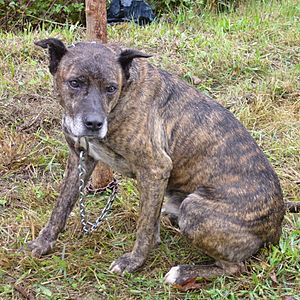Villano de Las Encartaciones facts for kids

In Ormaiztegi, Gipuzkoa
|
|||||||||||
| Other names |
|
||||||||||
|---|---|---|---|---|---|---|---|---|---|---|---|
| Origin | Spain | ||||||||||
|
|||||||||||
| Notes | Recognised in Spanish law | ||||||||||
| Domestic dog (Canis lupus familiaris) | |||||||||||
The Villano de Las Encartaciones is a large dog breed from Spain. It comes from a region called Las Encartaciones in the Basque Country. You can also find these dogs in nearby areas like Álava, eastern Cantabria, and northern Burgos.
These dogs are special because they help farmers manage a type of mountain cattle called Monchina. They are very good at bringing these cattle down from the mountains, especially between October and December. The Villano is one of five special dog breeds from the Basque region.
Contents
History of the Villano Dog
The Villano dog has a long history in the Basque Country. It has always been a working dog, helping people in the mountains. Its story is closely linked to the Monchina cattle. Some people even say that one could not exist without the other!
How the Breed Changed
Long ago, the Villano was a smaller dog. Farmers used two different types of dogs to work with the Monchina cattle. The Villano would help gather and move the cattle. Then, larger dogs, like the Alano Español, would help catch them.
In the 1960s, breeders started to mix these two types of dogs. They wanted to create one super dog that could do both jobs. This mixing led to the Villano we know today. In 1997, a special club was formed to protect and promote the Villano breed.
Official Recognition
The Villano is one of five unique dog breeds from the Basque Country. The others are the Basque Shepherd Dog, the Erbi Txakur, the Pachón Navarro, and the Villanuco de Las Encartaciones. In 2001, the government officially recognized these dogs as traditional Basque breeds. Later, in 2005, the Villano was added to the list of dog breeds recognized by the Spanish government.
An Endangered Breed
Sadly, the Villano de Las Encartaciones is a very rare dog breed. It is one of the most endangered breeds in the Basque Country. In 2009, there were fewer than 200 of these dogs officially registered. This means it's very important to help protect them!
What Does a Villano Look Like?
Villano dogs are quite large.
- Male dogs usually stand about 57 to 60 centimeters (about 22 to 24 inches) tall at the shoulder.
- Female dogs are a bit smaller, standing about 55 to 57 centimeters (about 21 to 22 inches) tall.
What the Villano Dog Does
The main job of the Villano dog is to help manage Monchina cattle. These cattle live in the mountains of Cantabria and the Basque Country. The dogs are especially good at helping farmers bring the cattle down from the high pastures when winter approaches.
The Villano is also a brave and strong dog. Because of these qualities, it is sometimes used for boar hunting. It can help catch wild boars, showing its power and courage.
See also
In Spanish: Villano de Las Encartaciones para niños

